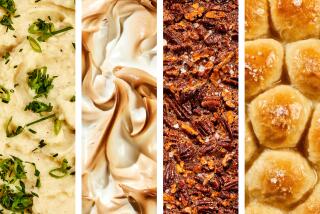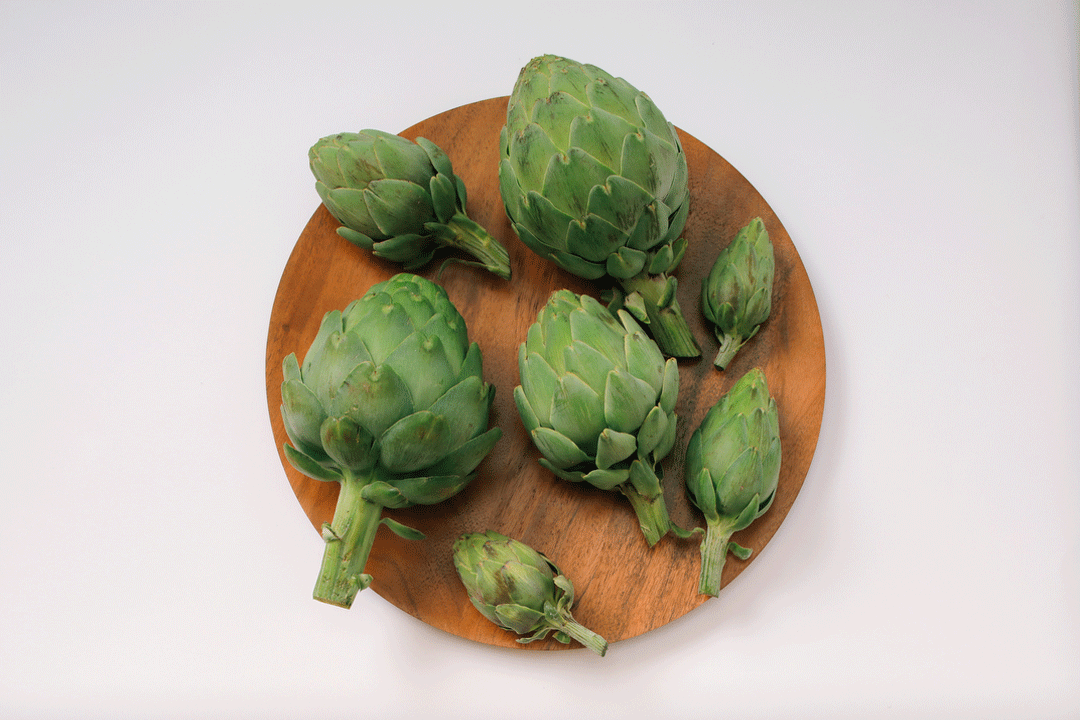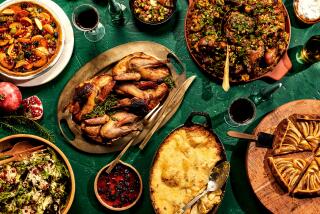The Ultimate Turkey
- Share via
For most American cooks, Thanksgiving morning comes at 4 a.m. While everybody else is cozily wrapped in warm blankets dreaming of stuffing and sweet potatoes, you’ve got to get up and start cooking. Why? Because the big bird needs to spend the better part of the day in the oven, and if you’re going to get the pies baked and the stuffing started, you’ve got to be up long before dawn.
And every year on the day before Thanksgiving, American cooks look at the directions for cooking the turkey and say to themselves: Eight hours? Does this bird really need to cook eight hours? When the turkey comes out of the oven, having dutifully cooked itself into a state of dryness, American cooks sigh, make gravy and say to themselves: Why did this bird have to cook so long? Every Thanksgiving we swear that next year’s turkey will be better.
Then next year comes along and all over America, cooks look in books and call turkey hotlines and get the same advice--for safety’s sake, cook the turkey to an internal temperature of 185 degrees. They start calculating and realize that for a really big bird, it’s another 4 a.m. wakeup call. And because American cooks are conscientious people who don’t want to make their families sick, they sigh, turn on the oven and stick the turkey in for the better part of the day.
This year we were determined to change all that. We called government agencies, food safety hotlines, even turkey producers to ask a basic question. At what temperature is a turkey really done? Estimates ranged from a low of 160 degrees to the standard 185 degrees.
The Department of Agriculture’s Meat and Poultry Hotline was typical. Under the topic “Turkey Fundamentals,” you’re advised to cook to an internal temperature of 180 degrees--at 325 degrees, 15 to 18 minutes per pound for an unstuffed bird, 18 to 24 minutes for one with stuffing. So we pushed the button to speak to a live expert and asked: At what temperature are food-borne bacteria considered dead? Our friendly helper said she would check for a more specific answer. While we were on hold, we were surprised to hear the recorded background tape advise that turkey is considered safe when the internal temperature taken at the thickest part of the thigh reaches 160 degrees , or the temperature of the stuffing reaches 165 degrees. After a moment, our expert came back on the line with another surprise: Food-borne bacteria are considered dead when the internal temperature reaches 147 degrees. Why then, we asked, would the “Turkey Fundamentals” tape advise 180 degrees? “Oh, that’s for maximum palatability,” she said brightly.
Obviously, one person’s palatability is another’s shoe leather. But we had uncovered some important information. From a strictly food safety point of view, you can pull your turkey out of the oven when it reaches an internal temperature of 150 degrees. Anything above that is strictly a matter of taste.
So we cooked our first turkey. Figuring that a turkey will continue cooking even after it is removed from the oven (chefs call this the “push” and the standard estimate is an additional 10 degrees), we cooked the bird until a thermometer stuck deeply into the breast registered 145 degrees. At 325 degrees, this took 1 1/2 hours for a 12 1/2-pound turkey--roughly 7 minutes per pound. Turkey will register different temperatures in different parts of its anatomy; at the thickest portion of the thigh, this turkey registered 150 degrees, and it registered as high as 165 degrees in some parts of the breast. We knew that we’d have a moist turkey, but this one was a little too moist. When we cut into the turkey, it was pink and still slightly uncooked close to the bone. Clearly, it had not cooked long enough.
So we cooked our second turkey. This one was slightly larger (14 pounds). Again, we cooked it at 325 degrees. We checked the turkey at about 2 hours, and it registered 155 degrees at the breast. We started to take it out of the oven and took the stuffing’s temperature--barely 125 degrees deep inside, well below any of the USDA’s recommendation. So, the turkey went back into the oven. By the time the stuffing was hot enough for safety, the turkey was 185 degrees and totally overcooked.
But we had uncovered the culprit and had solved the case of the overcooked American turkey: The stuffing did it. A lot of very dense matter stuffed into the cavity of a very large bird is so insulated from the heat of the oven that it takes a long time to cook. So long, in fact, that it is virtually impossible to cook the stuffing to a safe temperature without overcooking the bird that surrounds it.
But does it make sense to cook an expensive turkey until it’s dry just to get some stuffing? Probably not. So we began cooking unstuffed turkeys. In one memorable experiment we cooked a 12 1/2-pound bird, unstuffed and untrussed, at 500 degrees. In one hour--less than five minutes per pound--it was cooked to a perfect 165 degrees. The turkey was delicious too. But there were two problems: The kitchen was so filled with smoke that the fire alarms went off. And there wasn’t any stuffing.
In the end, Thanksgiving just isn’t Thanksgiving without stuffing. You can, of course, make stuffing and cook it in a pan. But who wants to eat stuffing that has had no contact with the turkey?
We were pondering this dilemma--even considering the wisdom of pre-cooking the stuffing before putting it in the bird--when we had an idea: What if we put the stuffing under the skin? That would give the stuffing contact with the juices of the turkey without leaving it to shiver deep inside the center of the bird. As an added benefit, it might even insulate the breast a bit, keeping the white meat moist while the dark meat cooked through.
We began with a 13-pound turkey. Using our hands, we separated the skin of the breast from the breast meat and packed it with a full recipe of bread stuffing. We decided to turn up the heat; this time we put the turkey into a 350-degree oven. An hour and 40 minutes later the bird was golden, the skin beautifully puffed up. The thermometer, stuck into the deepest part of the breast near the bone, registered 155 degrees. It was hard to believe that after such a short time the turkey could possibly be done. “I’m not eating uncooked turkey,” said one skeptic, promising if there was one spot of pink she’d refuse to taste it. But to her surprise--to everyone’s, actually--the turkey was perfectly cooked. It was moist and delicious. It was, we decided, the best turkey that any of us had ever tasted. We were jubilant.
And then slightly suspicious. Getting out the calculator we realized that we had cooked the turkey little more than 7 1/2 minutes a pound. Would this, we wondered, work with a larger bird?
We tried a 15 1/2-pounder--not a giant turkey, but enough to feed 10 hungry people. We cooked it an hour and 40 minutes, tested it, then put it back in for another 30 minutes--a total of two hours and 10 minutes and about 8 1/2 minutes per pound. This turkey was even more wonderful than the last one.
Finally we tried a truly giant 20-pound bird. Repeating the same technique, this one reached 155 in 2 hours and 20 minutes--just seven minutes a pound. It was good, but slightly less wonderful than the previous two. In our electric oven, the breast of the giant turkey was too close to the top heating element and the cooking was a bit uneven. It didn’t seem possible, but we had managed to produce a huge, partially overcooked turkey in less than two and a half hours; the breast meat on this bird was actually dry.
We’ve cooked a few more turkeys by this method. It always works, but it seems to work best with small to medium turkeys. If you’re a person who always buys the biggest turkey you can find, don’t despair. Even if you need to feed a lot of people, it’s faster to cook two medium turkeys by this method than one large one in the traditional manner. Look at it this way: You not only end up with a lot more stuffing--you also get a lot more sleep.
THE ULTIMATE TURKEY
1 (12- to 16-pound) turkey
Salt, pepper
1 stalk celery, cut up
1 carrot, cut up
1 small onion
4 to 6 cups stuffing
Melted butter
Wash turkey inside and out. Pat dry. Season to taste with salt and pepper.
Run fingers carefully between skin and flesh of turkey, loosening skin. Working slowly, push stuffing in thin layer under breast and thigh of turkey. Put celery, carrot and onion in cavity. Tie legs closed with kitchen twine.
Put turkey in large pan, brush with melted butter and roast, breast-side up, at 350 degrees 7 to 9 minutes per pound, or until turkey registers 155 to 160 degrees when thermometer is placed deep into breast nearest bone.
Remove from oven and let stand 20 minutes before carving. Makes 12 to 16 servings.
The turkey’s got to be good, but what’s inside counts plenty.
This rich and delicious stuffing is made almost entirely of dried fruits and nuts. Because it is so untraditional, you may not want it to be the only stuffing that you make this year. But if you’re planning on two turkeys, consider this for one of them.
BREAD-LESS STUFFING
1 cup dried apricots
1 cup raisins
1 cup pitted prunes
1/2 cup currants
1/4 cup bourbon
1/4 cup butter
3 apples, diced, unpeeled
3 onions, diced
3 stalks celery, diced
1 cup unsalted cashews
1 cup walnut halves
1 cup whole almonds
2 cups cranberries
1 teaspoon ground ginger
1 teaspoon ground cinnamon
1 teaspoon ground cloves
2 teaspoons summer savory
1 cup minced parsley
2 teaspoons salt
2 eggs, beaten
Mix apricots, raisins, prunes and currants in small plastic food bag. Add bourbon, close top and macerate overnight.
Melt butter in large saute pan. Add apples, onions and celery and saute 10 minutes.
Mix cashews, walnuts, almonds, cranberries, ginger, cinnamon, cloves, savory, parsley, salt and eggs in large bowl. Add sauteed apple mixture and macerated fruit mixture. Mix well and stuff into turkey. Makes about 8 cups, or enough for 18-pound turkey.
Each serving contains about:
601 calories; 693 mg sodium; 69 mg cholesterol; 34 grams fat; 69 grams carbohydrates; 12 grams protein; 4.19 grams fiber.
This stuffing may have come from a chicken book, but that’s no reason to keep it away from your turkey--it’s delicious.
APPLE, APRICOT AND WALNUT STUFFING (From “Faye Levy’s International Chicken Cookbook”)
1 cup walnuts
1 cup finely diced dried apricots
1/4 cup raisins
1/2 cup Calvados, applejack or cider
8 to 10 ounces day-old white bread or French or Italian bread
6 tablespoons unsalted butter
1 large onion, finely chopped
1 cup chopped celery
2 1/2 cups peeled, finely chopped tart green apples
Salt
Freshly ground black pepper
1/8 teaspoon ground cloves
1 teaspoon minced fresh thyme or 1/4 teaspoon dried, crumbled
1 teaspoon minced fresh sage or 1/4 teaspoon dried, crumbled
6 tablespoons chicken or turkey stock
Toast walnuts on rimmed baking sheet at 350 degrees until lightly browned, about 5 minutes. Cool nuts and coarsely chop.
Combine apricots, raisins and Calvados in small saucepan and mix well. Bring to simmer. Remove from heat. Cover and let stand 30 minutes, stirring occasionally.
Reduce oven temperature to 275 degrees. Cut bread into 1/2-inch cubes to make 2 quarts and spread out on large baking sheet. Bake, stirring frequently, until crisp and dry, about 20 minutes. Cool and transfer to large bowl.
Melt butter in large skillet over medium heat. Add onion, celery and apples and season to taste with salt and pepper. Saute until onion is tender but not brown, about 10 minutes. Add cloves, thyme and sage and stir until blended. Remove from heat.
Add onion mixture, nuts and apricot mixture with liquid to bread and toss lightly. Gradually add stock, tossing lightly. Mixture may appear dry but will become moist from juices in bird. Season to taste with salt and pepper. (Stuffing can be refrigerated, covered, up to 1 day.) Makes 8 to 9 cups, enough for 1 medium turkey or 2 chickens.
Variation:
To bake stuffing separately, spoon into greased 2 1/2-quart casserole and dot with butter. Bake, covered, at 350 degrees about 15 minutes, then pour 1/4 cup chicken or turkey stock evenly over top. Bake 15 minutes more. Pour another 1/4 cup stock evenly over top. Bake 15 minutes longer, uncovering last 10 minutes for crisper top. Serve hot.
Each serving contains about:
498 calories; 305 mg sodium; 32 mg cholesterol; 26 grams fat; 54 grams carbohydrates; 8 grams protein; 2.41 grams fiber.
This colorful stuffing of mixed meats produces rich dripping s for a truly savory gravy. You may also use it to stuff a boned and rolled turkey breast. If you cut the recipe in half, you can use it to stuff a whole boned chicken.
FORCEMEAT TURKEY STUFFING
1 1/2 pounds ground pork
1/2 pound lean bacon, chopped or coarsely ground
12 ounces Cheddar cheese, shredded
1 cup raisins
6 tablespoons sweet pickle relish
2 eggs
2 medium cooked carrots, peeled and diced
1 cup frozen green peas, thawed
6 ounces cooked ham, cut julienne
3 Spanish chorizos de Bilbao or small pepperoni, diced
3 to 4 hard-cooked eggs, quartered
Combine ground pork, bacon, cheese, raisins, pickle relish, unbeaten raw eggs, carrots, peas, ham, chorizos and cooked eggs in large bowl. Mix gently but thoroughly. Makes enough stuffing for 12- to 15-pound turkey, or 12 servings.
Each serving contains about:
501 calories; 1,069 mg sodium; 182 mg cholesterol; 35 grams fat; 18 grams carbohydrates; 28 grams protein; 0.61 gram fiber;
Many of the flavors that go into Southern California cooking--corn, chiles, sweet red peppers--show up in this stuffing.
SOUTHERN CALIFORNIA CORNBREAD STUFFING
1 cup minced onion
1/2 cup julienned sweet red pepper strips
1 cup sliced celery
1 clove garlic, minced
1/4 cup butter
1/4 cup minced fresh sage leaves
1 (14-ounce) can artichoke hearts, drained and quartered
1 (4-ounce) can whole green chiles, drained and cut in thin strips
4 cups cubed cornbread
1 cup shredded Cheddar cheese
1 cup hot chicken broth
Salt, pepper
Saute onion, red pepper strips, celery and garlic in butter until vegetables are tender. Stir in sage, artichoke hearts and chiles. Saute until heated through. Toss cornbread and cheese together in large mixing bowl. Add hot vegetable mixture and toss gently but thoroughly. Pour chicken broth over and continue tossing. Season to taste with salt and pepper. Makes about 6 cups stuffing, enough for 8- to 10-pound turkey, or 8 servings.
Each serving contains about:
179 calories; 425 mg sodium; 39 mg cholesterol; 12 grams fat; 13 grams carbohydrates; 7 grams protein; 0.95 gram fiber.
Donna Deane developed this recipe in The Times Test Kitchen as a more healthful alternative to meat sausage stuffing. Besides the obvious turkey-turkey symmetry, the stuffing tastes terrific.
BREAD STUFFING WITH TURKEY SAUSAGE
1 clove garlic, minced
1/2 cup minced onion
1/4 cup butter
1 tablespoon minced fresh rosemary leaves
1 tablespoon minced fresh marjoram leaves
1 cup hot turkey or chicken broth
4 cups herb-seasoned bread cubes
1/2 cup chopped water chestnuts
1 cup crumbled, cooked turkey sausage
Salt, pepper
Saute garlic and onion in butter until tender. Stir in rosemary and marjoram and continue sauteing 1 to 2 minutes. Stir in turkey broth and bring mixture to simmer.
In large mixing bowl, combine bread cubes, water chestnuts and sausage and toss until well mixed. Pour broth mixture over, tossing to mix evenly. Season to taste with salt and pepper. Makes about 4 cups stuffing, enough for 8-pound turkey, or 6 servings.
Each serving contains about:
219 calories; 1,084 mg sodium; 29 mg cholesterol; 10 grams fat; 25 grams carbohydrates; 8 grams protein; 0.38 gram fiber.
Plenty of meat goes into this stuffing--but that’s not all. It’s got a lot of the traditional ingredients of Italian cooking, including olive oil, spinach and Parmesan cheese.
HIGH-PROTEIN DRESSING
1 pound pork sausage
1/2 pound ground veal
1/2 pound ground pork
2 onions, chopped
6 stalks celery and leaves, chopped
1/4 cup chopped parsley
6 cups cubed stale bread
4 eggs, beaten
1 (10-ounce) package frozen chopped spinach, thawed
1 cup grated Parmesan cheese
2 teaspoons dried sage leaves
1 clove garlic, chopped
1 cup broth from boiling neck and giblets
2 tablespoons olive oil
1 tablespoon butter
In large skillet, cook sausage, veal and pork, covered, until cooked through, about 15 minutes. Stir with fork to keep crumbly. Add chopped onions, celery and parsley. Cook, covered, until tender.
Place bread cubes in bowl and add meat mixture, eggs, spinach, cheese, sage, garlic and broth combined with olive oil and butter. Mix well. Makes 6 to 8 cups stuffing, enough for 8- to 10-pound turkey, or 8 servings.
Each serving contains about:
495 calories; 968 mg sodium; 196 mg cholesterol; 30 grams fat; 25 grams carbohydrates; 31 grams protein; 0.8 gram fiber.
More to Read
Eat your way across L.A.
Get our weekly Tasting Notes newsletter for reviews, news and more.
You may occasionally receive promotional content from the Los Angeles Times.










